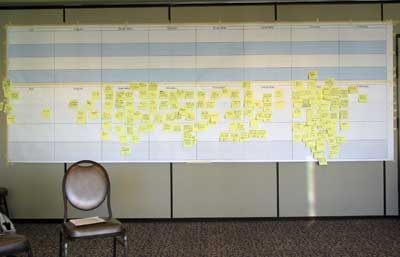What element of a project retrospective, in your experience, separates the average retrospective from the outstanding? For today, I would answer, “A visual history of the project created by the participants during the retrospective.”
What does a visual project history look like? Why is it a key element to an outstanding retrospective?
This photo shows a visual project history from a retrospective that I led.

The canvas for this retrospective is 15 feet long and 5 feet high. The yellow items on the canvas are post-it notes created by the participants.
The participants invested 2 hours creating this visual history of the project. To a person they thought this time was well invested.
Why does creating a visual project history lead to a more successful retrospective? It refreshes each participant’s memory about the history of the project; it delays interpreting the history of the project until everyone has had a chance to contribute their viewpoint of the history; it enables a group memory of the project to emerge from the individual viewpoints; and it enable the participants to see and explore patterns in the history data.
After creating the history of the project, the state of the participants is heightened. You will hear more thoughtful answers to questions, such as: What did we do during this project that we would benefit from doing in the next? What did we do during this project that we would benefit from doing differently in the next?
Like a coach who uses exercises to warm up athletes before they perform, warm up retrospective participants by creating a visual project history before asking them to perform.
Leave a Reply